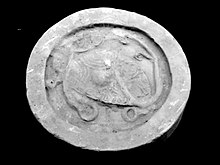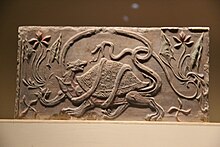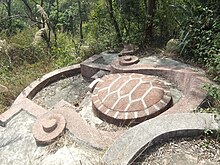Black Tortoise
| Black Tortoise | |||||||||||
|---|---|---|---|---|---|---|---|---|---|---|---|
 The Black Tortoise depicted on a Chinese tile | |||||||||||
| Chinese name | |||||||||||
| Chinese | 玄武 | ||||||||||
| Literal meaning | Mysterious ~ Dark ~ Black Warrior | ||||||||||
| |||||||||||
| Vietnamese name | |||||||||||
| Vietnamese alphabet | Huyền Vũ | ||||||||||
| Chữ Hán | 玄武 | ||||||||||
| Korean name | |||||||||||
| Hangul | 현무 | ||||||||||
| Hanja | 玄武 | ||||||||||
| |||||||||||
| Japanese name | |||||||||||
| Kanji | 玄武 | ||||||||||
| Hiragana | げんぶ | ||||||||||
| |||||||||||
| Black Warrior of the North | ||
|---|---|---|
Hanyu Pinyin | Běifāng Xuánwǔ | |
The Black Tortoise is one of the
It represents the north and the winter season, thus it is sometimes called Black Warrior of the North (Chinese: 北方玄武; pinyin: Běifāng Xuánwǔ).
In Japan, the characters 玄武 are pronounced as Genbu. It is said to protect Kyoto on the north side, being one of the four guardian spirits that protect the city. It is represented by the Kenkun Shrine, which is located on top of Mt Funaoka in Kyoto.
An important
History
During the Han dynasty, people often wore jade pendants that were in the shape of turtles. Originally, there was a legend that said that turtles could not mate with other turtles, only snakes. This is why the Black Tortoise is depicted with a snake on its back.
The northern gates of
Legends

In ancient
Xuanwu

In the
Other Chinese legends[
According to another source,[citation needed] once Xuanwu had begun his study of the Way, he discovered that he must purge himself of all of his past sins to become a god. He learned to achieve this by washing his stomach and intestines in the river. Washing his internal organs, his sins dissolved into the water in a dark, black form. These then formed into a black tortoise and a snake who terrorized the country. Once Xuanwu learned of this, he returned to subdue them as in the other story.
Seven Mansions of the Black Tortoise
As with the other three Symbols, there are seven astrological "Mansions" (positions of the Moon) within the Black Tortoise. The names and determinative stars are:[8][9]
| Mansion no. | Name | Pinyin | Translation | Determinative star |
|---|---|---|---|---|
| 8 | 斗 | Dǒu | (Southern) Dipper | φ Sgr |
| 9 | 牛 | Niú | Ox | β Cap |
| 10 | 女 | Nǚ | Girl | ε Aqr |
| 11 | 虛 | Xū | Emptiness | β Aqr |
| 12 | 危 | Wēi | Rooftop |
α Aqr |
| 13 | 室 | Shì | Encampment | α Peg |
| 14 | 壁 | Bì | Wall | γ Peg |

See also
- Ao - the great turtle of early Chinese mythology
- stelæ
- Cetus in Chinese astronomy - Cetus and Black Tortoise correspond on astrology, and both creatures possess affinities to waters and travel to underworlds to guide people[10][11]
- Fushigi Yûgi: Genbu Kaiden
Notes
- ^ Eastern Han philologist Xu Shen stated that 武; wǔ "warrior" was a Jianghuai dialectal word for 士; shì "knight" when annotating this passage 「夫死生同域,不可脅陵,勇武一人,為三軍雄。」 "One for whom death and life are the same territory, who cannot be threatened, such a single brave warrior is the hero of the Three Armies."[2][3]
References
- S2CID 164550058– via JSTOR.
- ^ Liu An (compiler), Xu Shen (annotator). Huainanzi, "Survey Obscurities". Main text: 「夫死生同域,不可脅陵,勇武一人,為三軍雄。」; Annotation: 「武士也;江淮間謂士曰武。」; Siku Quanshu version. vols. 4-7, p. 96 of 160
- ^ Liu An (2010) The Huainanzi: A Guide to the Theory and Practice of Government in Early Han China. Translated and edited by John S. Major, Sarah A. Queen, Aandrew Seth Meyer, and Harold D. Roth. New York: Columbia University Press, 2010. p. 215
- ^ Zhang, Qian (2017). "China's guardians of the galaxy". Shanghai Daily.
The four beasts are Qing Long (Azure Dragon), the guardian of the East; Bai Hu (White Tiger), the guardian of the West; Zhu Que (Vermilion Bird), the guardian of the South; and Xuan Wu (Black Warrior), the guardian of the North. This quartet originated from the 28 xingxiu ("mansions") in the Chinese constellation system.
- ^ Pregadio, Fabrizio (editor) (2008). The Encyclopedia of Taoism A-Z: Volume 1 & 2. p. 119, 194, 223, 478, 909, 1266
- ^ de Groot, Jan Jakob Maria (1892), The Religious System of China, vol. III, Brill Archive, pp. 1082–1083
- ^ 李永球 (Li Yongqiu) (2010-03-07), 各籍貫墳墓造型 [In every land, its own kind of graves], Sin Chew Daily, archived from the original on 2010-05-31, retrieved 2012-03-21
- ^ "The Chinese Sky". International Dunhuang Project. Archived from the original on 2015-11-04. Retrieved 2011-06-25.
- ISBN 0-7923-4066-3. Retrieved 2011-06-25.
- ^ National Museum of Korea, 2007, Black Tortoise and Serpent, the Guardian Deity of the North
- University of Pennsylvania Museum of Archaeology and Anthropology
